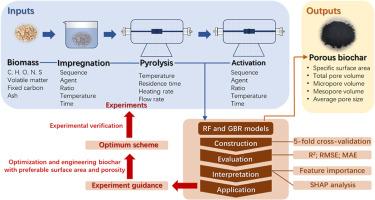Prediction and optimization design of porous structure properties of biomass-derived biochar using machine learning methods
IF 9
1区 工程技术
Q1 ENERGY & FUELS
引用次数: 0
Abstract
Biochar produced from biomass by pyrolysis and activation is a platform porous carbon material that has been widely used in many areas. The porosity properties of biochar such as specific surface area (SSA), total pore volume (Total_PV), micropore volume (Micro_PV), mesopore volume (Meso_PV), and average pore size (Average_PS) are essential to biochar applications. Although previous machine learning (ML) models can precisely predict SSA and Total_PV, these models are unable to comprehensively predict the other porosity characteristics. More importantly, activation, which is a critical process for preparing high-porosity biochar, was generally not considered in previous studies. Here, six single-target models were established first based on pyrolysis & activation conditions for the prediction of SSA, Total_PV, Micro_PV, Meso_PV, Average_PS, and yield, obtaining test R2 of 0.89, 0.86, 0.88, 0.89, 0.76 and 0.91, respectively. Then, a multi-target model was established for simultaneous prediction with an average test R2 of 0.87. ML model interpretation indicated agent type and ratio were crucial to porosity properties. Finally, activation and direct pyrolysis biochar production optimum schemes were derived from ML model for a high porosity. Favorable experimental verification results were obtained with validation R2 of 0.98, indicating the great potential of using ML for biochar engineering.

利用机器学习方法预测和优化设计生物质衍生生物炭的多孔结构特性
生物质经热解和活化产生的生物炭是一种平台多孔碳材料,已被广泛应用于许多领域。生物炭的孔隙率特性,如比表面积(SSA)、总孔体积(Total_PV)、微孔体积(Micro_PV)、中孔体积(Mes_PV)和平均孔径(Average_PS)对生物炭的应用至关重要。虽然以前的机器学习(ML)模型可以精确预测 SSA 和总孔隙率,但这些模型无法全面预测其他孔隙率特征。更重要的是,活化是制备高孔隙率生物炭的关键过程,但以往的研究一般都没有考虑到这一点。在此,首先根据热解& 和活化条件建立了六个单目标模型,用于预测 SSA、Total_PV、Micro_PV、Meso_PV、Average_PS 和产量,测试 R2 分别为 0.89、0.86、0.88、0.89、0.76 和 0.91。然后,建立了一个多目标同时预测模型,平均测试 R2 为 0.87。多目标模型解释表明,药剂类型和比例对孔隙率特性至关重要。最后,根据 ML 模型得出了活化和直接热解生物炭生产的最佳方案,以获得高孔隙率。实验验证结果良好,验证 R2 为 0.98,表明使用 ML 进行生物炭工程具有巨大潜力。
本文章由计算机程序翻译,如有差异,请以英文原文为准。
求助全文
约1分钟内获得全文
求助全文
来源期刊

Energy
工程技术-能源与燃料
CiteScore
15.30
自引率
14.40%
发文量
0
审稿时长
14.2 weeks
期刊介绍:
Energy is a multidisciplinary, international journal that publishes research and analysis in the field of energy engineering. Our aim is to become a leading peer-reviewed platform and a trusted source of information for energy-related topics.
The journal covers a range of areas including mechanical engineering, thermal sciences, and energy analysis. We are particularly interested in research on energy modelling, prediction, integrated energy systems, planning, and management.
Additionally, we welcome papers on energy conservation, efficiency, biomass and bioenergy, renewable energy, electricity supply and demand, energy storage, buildings, and economic and policy issues. These topics should align with our broader multidisciplinary focus.
 求助内容:
求助内容: 应助结果提醒方式:
应助结果提醒方式:


